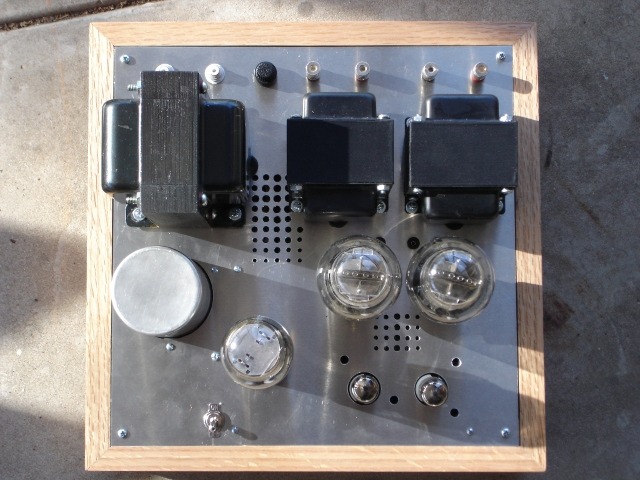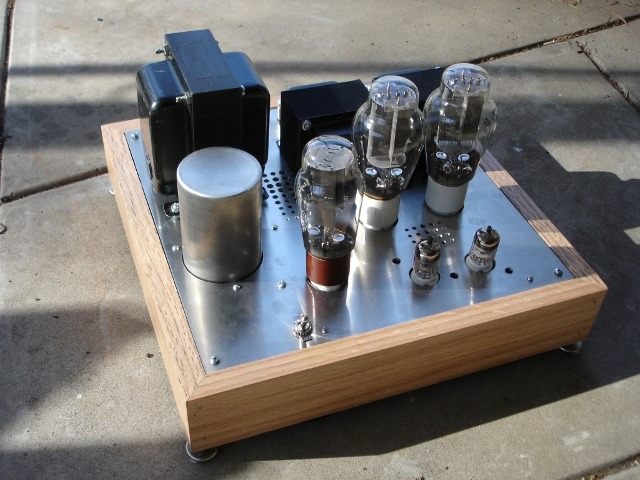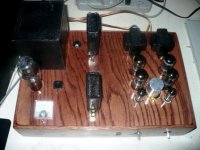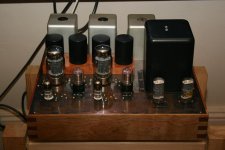RMS said:they all sounded good except the Chinese 6L6GC "Coke Bottle"
That tube is super cheap and really rugged. However, in use, it's output is lower than any other 6L6 tube I've seen and it doesn't sound as good. It has it's place in guitar amps or radios, but probably not really in high-end stuff. Though I have used the Chinese KT66s and they are very nice tubes. Though my current favorite production tubes are the Russian KT88s -- Tung Sol, EH, GL...
A modified Mullard 7+7W amp as a just completed as an early winter project. By todays standards the original Mullard design is a poor performer, and this one with different phasesplitter and front end tube totally outperforms the original by magnitudes. THD now 0.035% at 1KHz at 7W each channel with -3dB at 50KHz. hum& noise -80dB.
Tube line up,12GN7, ECC88 (sections parallelled as concertina) and ECL82's, the triode section of the pentode dumped.
Since I've got several obscure 12GN7's these TV video pentodes were once up-market 12BY7 replacements and have excellent linearity.
With a B+ of only 270V, this amp offers brilliant easy listening.
The main distortion reduction is in the o/p stage. Fixed bias is used and 43% UL taps instead of 20%. With 20% taps, thd doubles. For those wanting to build this, note the ECL82 pentode grids will require distortionless drive capable of 15+15V rms. This is considerably higher when compared for an EL84.
richy
Tube line up,12GN7, ECC88 (sections parallelled as concertina) and ECL82's, the triode section of the pentode dumped.
Since I've got several obscure 12GN7's these TV video pentodes were once up-market 12BY7 replacements and have excellent linearity.
With a B+ of only 270V, this amp offers brilliant easy listening.
The main distortion reduction is in the o/p stage. Fixed bias is used and 43% UL taps instead of 20%. With 20% taps, thd doubles. For those wanting to build this, note the ECL82 pentode grids will require distortionless drive capable of 15+15V rms. This is considerably higher when compared for an EL84.
richy
Attachments
baby huey amp (circuit design by Gingertube).
This is my first p2p build. Sounds stunning.
and the bijou headphone amp
An externally hosted image should be here but it was not working when we last tested it.
This is my first p2p build. Sounds stunning.
and the bijou headphone amp
An externally hosted image should be here but it was not working when we last tested it.
Adamus, I'd bet your'e finding your little (EL84) amp sounds loud,as mine does. Put the 7+7 Watter up on top of the 150+150 main frame amp as shown in pic, these small amps are way more value for money. The log power scale puts the big ones at a massive disadvantage as also the ridiculous weight for an Altlas man. 5kg instead of 65 kg.
The ECL82 pentode is nice and tame to work with, the triode couldn't be more performance miserable, so I dumped this bit...
I expected the sound quality of the 7+7 Watter to be bit' lower than the 150+150W beast; No so.
I can recommend small amps for anyone.
I will have to dig out the Gingertube design and examine it.
richy
The ECL82 pentode is nice and tame to work with, the triode couldn't be more performance miserable, so I dumped this bit...
I expected the sound quality of the 7+7 Watter to be bit' lower than the 150+150W beast; No so.
I can recommend small amps for anyone.
I will have to dig out the Gingertube design and examine it.
richy
Attachments
My new GM70 SET monoblock amplifier
My custom GM70 tube based 2x30 Watts monoblock SET amplifier. It was new built point-to point connections by using turrets. Amplifier has very loud and open sound, with lovely midrange and deep bass. Giving huge sound even without clipping at very high sound levels. No any audible hum with my 93db Tannoys even from zero distance from loudspeakers.
Explanation of design:
- Both halves of 6N8S tube are direct coupled to each other. The output of 6N8S tube also direct coupled to GM70 tube by using an anode choke to eliminate the sound loss especially in mid and high frequency bands. There is no any coupling or cathode capacitor used in this amplifier. Cathode leg of the GM70 power triode is directly connected to ground without any resistor or capacitor. Signal path is very short and design is so simple to provide extremely natural sound. Anode voltages for 6N8S and GM70 are separately provided by mosfet regulated power supply circuits. Filaments of both tubes are separately heated by regulated supply circuits to cancel the hum.
-Type: Mono block Single ended Class A1.
-Output Power: 2x30Watts to 6 or 8 Ohms.
-Feedback: No local or global feedback used.
-Bias: Adjustable fixed bias. One bi-color (Green-red) led and an adjustment trimmer is built on.
-Delay on circuit: Yes
-Tubes: Input tube; 6N8S (6SN7) , Output tube; GM70 copper plate.
-Output transformer: AE (Hi-end transformer company from Holland) Double C core 0,05mm laminations, max. 45Watts output, 6 and 8 0hms secondary.
-Speaker connectors: Gold plated, heavy-duty.
-Power consumption: 250Watts.
-Case/chassis: 2cm. thick polished hornbeam massive wooden case and 2mm thick steel chassis.
-Sizes: (Each mono block): 210mm(W) x 420mm(L) x 100mm(H); 19Kg.
An externally hosted image should be here but it was not working when we last tested it.
An externally hosted image should be here but it was not working when we last tested it.
An externally hosted image should be here but it was not working when we last tested it.
An externally hosted image should be here but it was not working when we last tested it.
An externally hosted image should be here but it was not working when we last tested it.
An externally hosted image should be here but it was not working when we last tested it.
An externally hosted image should be here but it was not working when we last tested it.
My custom GM70 tube based 2x30 Watts monoblock SET amplifier. It was new built point-to point connections by using turrets. Amplifier has very loud and open sound, with lovely midrange and deep bass. Giving huge sound even without clipping at very high sound levels. No any audible hum with my 93db Tannoys even from zero distance from loudspeakers.
Explanation of design:
- Both halves of 6N8S tube are direct coupled to each other. The output of 6N8S tube also direct coupled to GM70 tube by using an anode choke to eliminate the sound loss especially in mid and high frequency bands. There is no any coupling or cathode capacitor used in this amplifier. Cathode leg of the GM70 power triode is directly connected to ground without any resistor or capacitor. Signal path is very short and design is so simple to provide extremely natural sound. Anode voltages for 6N8S and GM70 are separately provided by mosfet regulated power supply circuits. Filaments of both tubes are separately heated by regulated supply circuits to cancel the hum.
-Type: Mono block Single ended Class A1.
-Output Power: 2x30Watts to 6 or 8 Ohms.
-Feedback: No local or global feedback used.
-Bias: Adjustable fixed bias. One bi-color (Green-red) led and an adjustment trimmer is built on.
-Delay on circuit: Yes
-Tubes: Input tube; 6N8S (6SN7) , Output tube; GM70 copper plate.
-Output transformer: AE (Hi-end transformer company from Holland) Double C core 0,05mm laminations, max. 45Watts output, 6 and 8 0hms secondary.
-Speaker connectors: Gold plated, heavy-duty.
-Power consumption: 250Watts.
-Case/chassis: 2cm. thick polished hornbeam massive wooden case and 2mm thick steel chassis.
-Sizes: (Each mono block): 210mm(W) x 420mm(L) x 100mm(H); 19Kg.
My SV811-3
my SV811-3 DHT SE amp almost ready
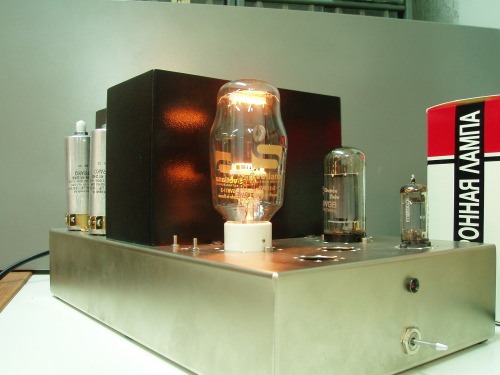
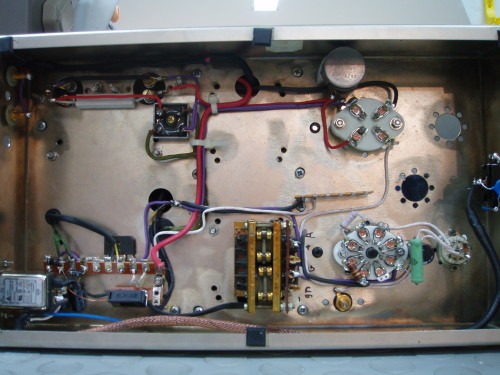
more details here : http://sarris.info/main/811a-single-ended-triode-power-amp
costas
my SV811-3 DHT SE amp almost ready


more details here : http://sarris.info/main/811a-single-ended-triode-power-amp
costas
Thank you for posting. Looks good!wicked1 said:
Which rectifier tube are you using and when measuring bias (through those holes), are you using some kind of contact plugs?
Also, any pictures of those tubes glowing?
Thanks! I'm so happy with it!
Rectifier is a 5u4g from aes. My hammond power tx just puts out way too much juice. I tried various tweaks to the circuit (smaller input cap, larger choke) and it still didn't bring the voltage down enough. I popped that 5u4g in there and it solved my voltage problem, as well as looking great.
Bias test points. The bare metal holes are screw holes for the bias adjust. The 4 black test points behind the power tubes (you can see 1 and 1/2 of them in that pic) are where I test the bias. I haven't tested it yet since I assembled it. I'm guessing I can just stick the ends of my multi-meter probes in them. There looks to be enough clearance around everything that I wont accidentally make any shorts.
Glowing tubes? Hopefully tonight! I finished the chassis assembly Saturday night, and when I snapped that photo Sunday morning, the wiring wasn't complete. I finished the wiring Sunday night. Had a busy day yesterday, and didn't want to take the chance of the first power up. SO, today. This should be the day for the glowing tube photo.. and I'll snap one of the under side while I'm at it, now that the wiring is complete.
I don't foresee any trouble w/ power up today. I have been using the amp for about a year.. it's just been all spread out on a plank of wood. So, basically just had to reconnect all the tx's in this new chassis.
Rectifier is a 5u4g from aes. My hammond power tx just puts out way too much juice. I tried various tweaks to the circuit (smaller input cap, larger choke) and it still didn't bring the voltage down enough. I popped that 5u4g in there and it solved my voltage problem, as well as looking great.
Bias test points. The bare metal holes are screw holes for the bias adjust. The 4 black test points behind the power tubes (you can see 1 and 1/2 of them in that pic) are where I test the bias. I haven't tested it yet since I assembled it. I'm guessing I can just stick the ends of my multi-meter probes in them. There looks to be enough clearance around everything that I wont accidentally make any shorts.
Glowing tubes? Hopefully tonight! I finished the chassis assembly Saturday night, and when I snapped that photo Sunday morning, the wiring wasn't complete. I finished the wiring Sunday night. Had a busy day yesterday, and didn't want to take the chance of the first power up. SO, today. This should be the day for the glowing tube photo.. and I'll snap one of the under side while I'm at it, now that the wiring is complete.
I don't foresee any trouble w/ power up today. I have been using the amp for about a year.. it's just been all spread out on a plank of wood. So, basically just had to reconnect all the tx's in this new chassis.
wicked1 said:I'm guessing I can just stick the ends of my multi-meter probes in them. There looks to be enough clearance around everything that I wont accidentally make any shorts.
 Very risky.
Very risky.A pair of these panel mount plugs per each channel (+ and - test probe for each lead of R18 and R29) will make it much easier.
Those are what I have on my test points! (except round ones, not hex on top)
Look right between the 300b's You can see a small black circle. That's one of the test jacks.
From the position of that photo, you can't really tell those are 3d test jacks and not just holes.
My amp is on, playing music! yay
Look right between the 300b's You can see a small black circle. That's one of the test jacks.
From the position of that photo, you can't really tell those are 3d test jacks and not just holes.
My amp is on, playing music! yay
My first Amp worthy of Display
This is a 6V6PP Fixed Bias. (excuse the one 5V6GT I could not find the fourth 6V6GTY I had squirreled away, then remembered it is on the Fender Tweed Deluxe Clone I built my Brother In-Law for his Birthday last year!)
B+ 250 - 6CG7's driver/splitter. Sounds Real nice driving my "Junk Pile" find Yamaha NS-A636's. Bass is a little "loose" or what I call "Boomy" or "Flabby" (left over from my Car Audio days) Not sure if that is just because these Yamaha's don't like anything below 40hz?
This is a 6V6PP Fixed Bias. (excuse the one 5V6GT I could not find the fourth 6V6GTY I had squirreled away, then remembered it is on the Fender Tweed Deluxe Clone I built my Brother In-Law for his Birthday last year!)
B+ 250 - 6CG7's driver/splitter. Sounds Real nice driving my "Junk Pile" find Yamaha NS-A636's. Bass is a little "loose" or what I call "Boomy" or "Flabby" (left over from my Car Audio days) Not sure if that is just because these Yamaha's don't like anything below 40hz?
JoshK said:Finally have something to share. My first ever tube amp is complete.
It was actually done a bit over a week ago but couldn't find my camera's battery charger.
Still have a tiny bit of hum, but I think I know why.
Josh,
Looks great. Well thought out layout. Didn't put the rectifier tubes on top of the input stages.
What is the top deck plate made out of?
Thanks. This is Pete Millett's SE KT88 E-linear amp. I used his layout so I can't take credit. The VR tubes are for the D3A's G2. The KT88's are wired for UL and then plate to plate feedback is done from the UL taps back to the input stage.
The amp sounds great, despite a little residual hum left to track down. I am reasonably certain it is the AC heaters. Couple tricks left to try there.
The top plate is patina'd copper epoxied to a thicker piece of aluminum.
The amp sounds great, despite a little residual hum left to track down. I am reasonably certain it is the AC heaters. Couple tricks left to try there.
The top plate is patina'd copper epoxied to a thicker piece of aluminum.
- Home
- Amplifiers
- Tubes / Valves
- Photo Gallery
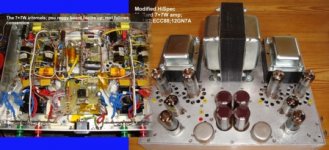
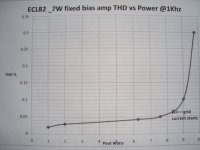
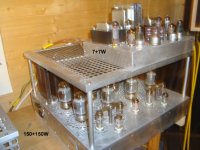
 Very nice.
Very nice.